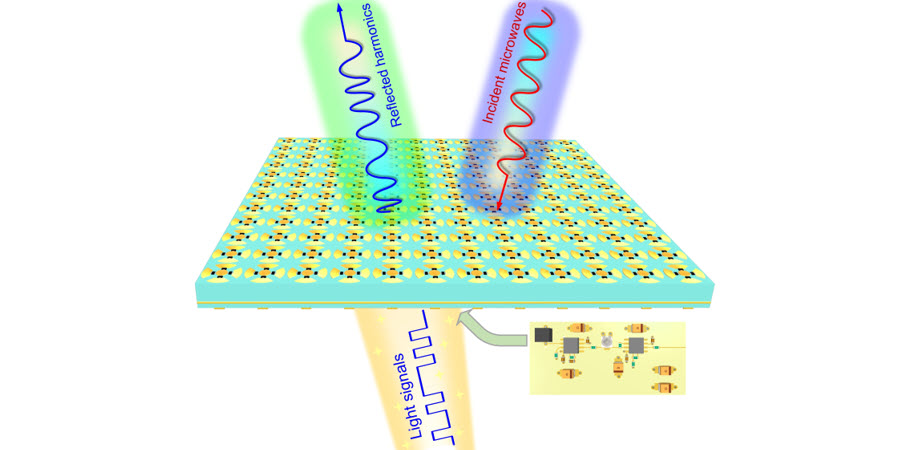Light-controllable time-domain metasurface for dynamic harmonic manipulation

Metasurfaces are artificial array structures consisting of subwavelength unit cells arranged on a specific two-dimensional surface. Dynamic, reconfigurable metasurfaces are an excellent way to manipulate electromagnetic (EM) waves flexibly.
Thanks to the work of Tie Jun Cui and his colleagues, programmable metasurfaces emerged in 2014. Programmable metasurfaces enable EM control in the spatial domain and are also naturally suitable for constructing the time-domain metasurfaces. Time-domain metasurfaces allow control of the EM spectrum, which opens up many attractive functions, such as Doppler cloaking, frequency conversion, and direct information processing. However, the wired electrical control method commonly adopted for time-domain metasurfaces operating at microwave frequencies has some limitations that make it difficult to realize certain desirable functions, like noncontact remote control.
Alternatively, an optical control approach offers noncontact, light-driven signals. Optically controlled devices show great potential for realizing advanced hybrid platforms. Recently, both reflection-type and transmission-type optically controlled programmable metasurfaces have been developed to manipulate EM beam shapes and EM amplitude under light illumination. These optically controlled metasurfaces manipulate microwaves in the spatial domain—but neglect the time domain.
As reported in Advanced Photonics, researchers from Southeast University (China) recently proposed and developed a light-controllable time-domain digital coding metasurface that can be used to manipulate microwave reflection spectra by time-varying light signals. The full-polarization dynamic metasurface is based on varactors and a high-speed photoelectric detection circuit. Its photoelectric detection circuit mainly consists of a photodiode chip and two hierarchical transimpedance amplifiers.
The photodiode is able to receive visible light signals and generate a weak photocurrent that is then amplified by transimpedance amplifiers to provide a sufficiently strong voltage-driven signal. The capacitance of the loaded varactor can be tuned dynamically by visible light, thus changing the reflection phase of the metasurface. As a result of periodic light signals with an intensity-changed time-coding sequence, the metasurface platform will produce harmonics based on phase modulation.
In the demonstration, the light-controllable time-domain metasurface is illuminated by light signals with two designed time-coding sequences. The measured results show that the metasurface can generate symmetrical harmonics and white-noiselike spectra, respectively, under these two cases.
According to Wei Xiang Jiang, professor at Southeast University’s State Key Laboratory of Millimeter Waves and one of the corresponding authors for the work, “The key to realizing the light-controllable time-domain metasurface is integrating a high-speed and high-sensitivity photoelectric detection circuit into a programmable digital metasurface. This work provides an actual route to control microwaves with visible light in the time domain on a single platform, which may helpful for developing advanced programmable multiphysics field devices and systems.”
Read the open access article by Zhang et al., “Light-controllable time-domain digital coding metasurfaces,” Adv. Photon. 4(2), 025001 (2022) doi 10.1117/1.AP.4.2.025001.
| Enjoy this article? Get similar news in your inbox |
|



